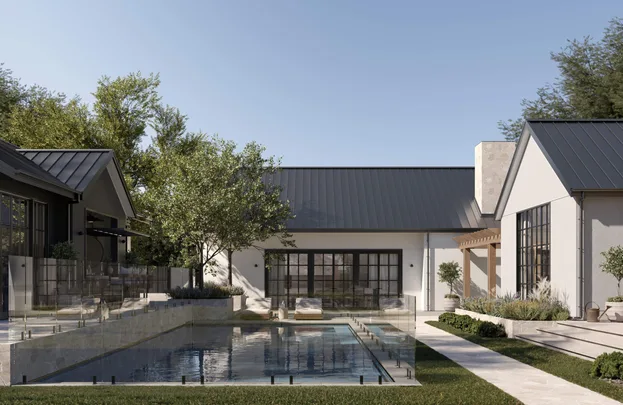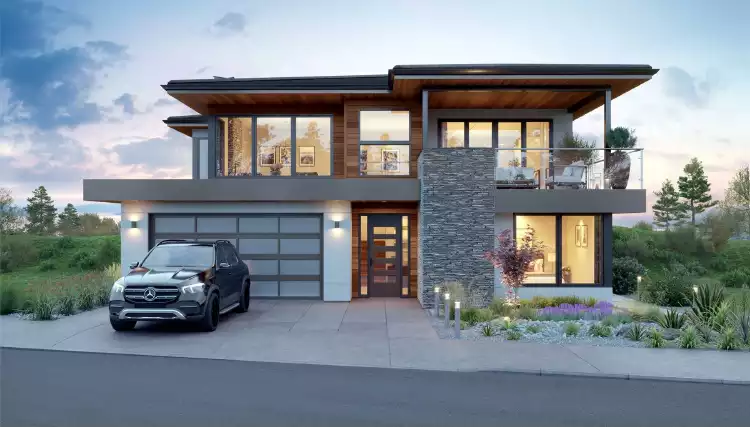Exploring the Benefits of Modern Home Architecture in Contemporary Design
The exploration of modern home architecture within contemporary design reveals a sophisticated interplay in between visual charm and practical effectiveness. By focusing on aspects such as energy effectiveness, enhanced indoor air top quality, and liquid changes in between indoor and outdoor spaces, modern-day styles deal with the advancing requirements of today's property owners. Moreover, the calculated use of all-natural light and personalization options welcomes a much deeper consideration of how these attributes can substantially improve daily living. As we check out these elements, it ends up being evident that the effects extend past mere aesthetic appeals, prompting additional inquiry right into their broader influence on lifestyle and sustainability.
Improved Power Efficiency
In contemporary home style, one frequently finds a substantial focus on improved power performance, which is vital in addressing increasing power prices and ecological concerns. Designers and building contractors are increasingly integrating ingenious style approaches and progressed technologies to optimize energy use in property rooms. This standard change is driven by a growing awareness of sustainability and the requirement to minimize carbon impacts.
Trick attributes of energy-efficient homes consist of superior insulation, energy-efficient windows, and the use of sustainable products. These style elements work in tandem to lessen warm loss in winter and decrease warm gain in summer, guaranteeing a comfortable living atmosphere year-round. Furthermore, contemporary homes commonly include renewable resource sources, such as solar panels, which not only lower dependence on non-renewable power however likewise offer potential cost financial savings for home owners.

Enhanced Indoor Air Quality
Prioritizing boosted indoor air top quality has come to be a hallmark of contemporary home architecture, as house owners increasingly acknowledge the importance of a healthy living setting. Contemporary design integrates innovative materials, ventilation systems, and clever innovation to advertise cleaner air within residential areas.

In addition, the design of contemporary homes regularly emphasizes natural ventilation, enabling fresh air to flow and reducing reliance on man-made environment control. Strategically placed windows, skylights, and vents assist in air movement, contributing to an environment that deals with interior air torpidity.
Additionally, incorporating biophilic design elements, such as indoor plants, not only improves visual allure yet also serves to cleanse the air. modern home architecture melbourne. Generally, by concentrating on enhanced interior air top quality, contemporary home style not just boosts the convenience and health of its owners yet additionally cultivates a lasting living setting that straightens with contemporary health and wellness and wellness requirements

Smooth Indoor-Outdoor Connection
As contemporary house owners look for to boost their living experiences, the concept of a smooth indoor-outdoor link has actually obtained significant traction in contemporary architecture. This design viewpoint obscures the limits in between indoor areas and the all-natural setting, advertising an unified conjunction that improves life.
Building components such as large gliding glass doors, huge home windows, and open layout facilitate this connection, allowing spaces to read move easily from inside to outdoors. These attributes not just produce a sense of openness but additionally urge involvement with nature, which can have extensive impacts on mental well-being.
Additionally, a seamless indoor-outdoor connection boosts the capability of living areas. Outside areas can act as expansions of the home, fitting different activities such as eating, amusing, or relaxation. By incorporating landscape design and exterior furnishings that complement interior decoration, house owners can produce welcoming settings that satisfy diverse lifestyles.
In enhancement, this architectural approach often stresses sustainability, as natural air flow and passive air conditioning techniques minimize dependence on artificial climate control. Inevitably, embracing a smooth indoor-outdoor connection fosters an extra dynamic, vibrant, and health-conscious living experience.
Making The Most Of All-natural Light
Natural light is a key aspect in modern home style, considerably boosting both aesthetic allure and resident well-being. The critical incorporation of huge windows, skylights, and open areas permits natural light to flooding interiors, producing vivid and inviting settings. This design method not just elevates the visual charm her response of a home however also promotes a link to the outdoors, advertising a sense of harmony and visibility.
Additionally, maximizing natural light adds to power efficiency, decreasing dependence on synthetic lights throughout the day. Homes created with this concept in mind often feature reflective surfaces and light-colored materials that magnify the results of all-natural light, guaranteeing that areas really feel brilliant and airy. This not only improves convenience however additionally decreases energy costs.
Additionally, exposure to natural light has been linked to enhanced mood and efficiency among passengers. By producing well-lit rooms that encourage communication and task, modern architecture can considerably impact the high quality of life within the home. Eventually, the thoughtful combination of natural light is a hallmark of contemporary design, mixing capability with elegance while cultivating a much healthier living setting.
Modification and Adaptability
The focus on maximizing all-natural light in modern-day home design effortlessly matches the principles of customization and adaptability. This architectural approach accommodates specific preferences, allowing homeowners to customize their living rooms to satisfy their distinct needs and way you can look here of livings. Modification in style enables the assimilation of individual appearances, whether through the option of materials, color schemes, or spatial setups.
Flexibility is an additional foundation of contemporary building patterns, helping with flexible living settings that can develop over time. Open up floor strategies, movable dividers, and multifunctional spaces are vital functions that support vibrant living arrangements. These facets equip property owners to create locations that can transform for numerous functions-- whether for work, recreation, or celebrations-- enhancing use without compromising design.
Moreover, the combination of wise home modern technology further amplifies personalization. Inevitably, modification and adaptability in modern home architecture foster a deeper connection between individuals and their living spaces.
Conclusion
In summary, modern home architecture in contemporary design presents many benefits, consisting of boosted power performance, enhanced interior air high quality, seamless indoor-outdoor connections, made the most of natural light, and increased customization options. These components jointly add to healthier living atmospheres and promote lasting techniques, ultimately benefiting both property owners and the broader community. The cutting-edge assimilation of appearances and capability within contemporary architecture not just raises the high quality of life yet additionally supports a more eco mindful future.
Comments on “Superior Services in Sustainable Residential Building for Long-Term Benefits”